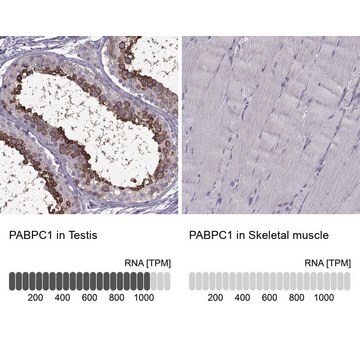推荐产品
生物源
mouse
品質等級
共軛
unconjugated
抗體表格
purified from hybridoma cell culture
抗體產品種類
primary antibodies
無性繁殖
10E10, monoclonal
形狀
buffered aqueous solution
分子量
antigen ~69 kDa
物種活性
hamster, canine, bovine, Xenopus, human, monkey
技術
immunocytochemistry: suitable
immunoprecipitation (IP): suitable
microarray: suitable
western blot: 0.5-1 μg/mL using whole cell extracts of HEK 293T cells
同型
IgG1
UniProt登錄號
運輸包裝
dry ice
儲存溫度
−20°C
目標翻譯後修改
unmodified
基因資訊
human ... PABPC1(26986)
一般說明
Monoclonal Anti-PABP (mouse IgG1 isotype) is derived from the 10E10 hybridoma produced by the fusion of mouse myeloma cells (SP2/0) and splenocytes from BALB/c mice immunized with recombinant human PABP. Poly(A) binding protein (PABP) is highly conserved between different organisms especially at the amino-terminal region of the protein that contains four RNA-binding domains (RBDs).
Poly(A) binding protein (PABP) possesses RNA recognition motifs (RRMs), a proline-rich region and a PABP C-terminal domain. The gene encoding this protein is localized on human chromosome 8q22.3.
免疫原
recombinant human PABP.
應用
Monoclonal Anti-PABP antibody produced in mouse has been used for immunofluorescence.
Monoclonal Anti-PABP antibody produced in mouse has been used in:
- Immunoblotting
- Immunostaining
- Immunoprecipitation
- Enzyme linked immunosorbent assay(ELISA)
- Immunocytochemistry
生化/生理作用
Poly(A) binding protein (PABP) has a role in mRNA translation and stability. It modulates gene expression. The protein binds to the poly(A) tail, bridges the ends of mRNA and forms a closed loop. This might help in translation initiation by promoting ribosome recruitment.
Poly(A) binding protein (PABP) is found in excess, relative to the amount of cytoplasmic poly(A) (three fold) and binds to its poly(A) target at high affinity (Kd of 7nM). The eukaryotic initiation factor, EIF4F complex, interacts with PABP indirectly via the PAIP-1 protein (PABP-interacting protein-1). As a consequence, an interaction between the 5′ and 3′ ends of mRNA occurs. This proximity between the mRNA ends contributes to its stability and enhances translation, since terminating ribosomes may start translation again.
外觀
Solution in 0.01 M phosphate buffered saline, pH 7.4, and 15 mM sodium azide.
免責聲明
Unless otherwise stated in our catalog or other company documentation accompanying the product(s), our products are intended for research use only and are not to be used for any other purpose, which includes but is not limited to, unauthorized commercial uses, in vitro diagnostic uses, ex vivo or in vivo therapeutic uses or any type of consumption or application to humans or animals.
未找到合适的产品?
试试我们的产品选型工具.
儲存類別代碼
10 - Combustible liquids
水污染物質分類(WGK)
nwg
閃點(°F)
Not applicable
閃點(°C)
Not applicable
Molecular dynamics of FMRP and other RNA-binding proteins in MEG-01 differentiation: the role of mRNP complexes in non-neuronal development
Marie McCoy
Biochemistry and Cell Biology = Biochimie Et Biologie Cellulaire (2016)
Poly(A) binding protein C1 is essential for efficient L1 retrotransposition and affects L1 RNP formation.
Dai L
Molecular and Cellular Biology (2012)
Poly(A) Binding Protein 1 Enhances Cap-Independent Translation Initiation of Neurovirulence Factor from Avian Herpesvirus
Abdessamad T
PLoS ONE (2014)
Hun-Way Hwang et al.
Cell reports, 15(2), 423-435 (2016-04-07)
Accurate and precise annotation of 3' UTRs is critical for understanding how mRNAs are regulated by microRNAs (miRNAs) and RNA-binding proteins (RBPs). Here, we describe a method, poly(A) binding protein-mediated mRNA 3' end retrieval by crosslinking immunoprecipitation (PAPERCLIP), that shows
Poly (A)-binding proteins: multifunctional scaffolds for the post-transcriptional control of gene expression
Brook M and Gray NK
Genome Biology, 4(7), 223-223 (2003)
我们的科学家团队拥有各种研究领域经验,包括生命科学、材料科学、化学合成、色谱、分析及许多其他领域.
联系技术服务部门








